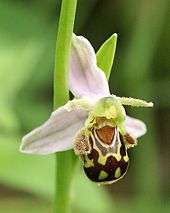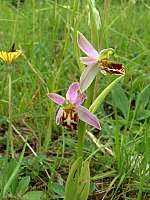Ophrys apifera
Ophrys apifera, known in Europe as the bee orchid, is a perennial herbaceous plant of the family Orchidaceae. It is remarkable as an example of sexually-deceptive pollination and floral mimicry as well as of a highly-selective and highly evolved plant–pollinator relationship.[2]
| Ophrys apifera | |
|---|---|
_(14374841786)_-_cropped.jpg) | |
| Scientific classification | |
| Kingdom: | Plantae |
| Clade: | Tracheophytes |
| Clade: | Angiosperms |
| Clade: | Monocots |
| Order: | Asparagales |
| Family: | Orchidaceae |
| Subfamily: | Orchidoideae |
| Genus: | Ophrys |
| Species: | O. apifera |
| Binomial name | |
| Ophrys apifera | |
| Synonyms[1] | |
| |
Description
Ophrys apifera grows to a height of 15–50 centimetres (6–20 in). This hardy orchid develops small rosettes of leaves in autumn. They continue to grow slowly during winter. Basal leaves are ovate or oblong-lanceolate, upper leaves and bracts are ovate-lanceolate and sheathing. The plant blooms from mid-April in continental Europe, but in the United Kingdom it flowers June to July. A flower spike is produced, composed from one to twelve flowers. The flowers have large sepals, with a central green rib and colour varying from white to pink, while petals are short, pubescent, yellow to greenish. The labellum is trilobed, with two pronounced humps on the hairy lateral lobes, the median lobe is hairy and similar to the abdomen of a bee. The labellum is remarkable for displaying at least four distinct colours, in addition to the two colours of the sepals and petals. Pattern of labellum colouration is quite variable. The gynostegium is at right angles, with an elongated apex.[3] Chromosomes 2n=36[4]
Distribution
Ophrys apifera is widespread across central and southern Europe, as well as North Africa and the Middle East. Its range stretches from Portugal, Ireland and Denmark east to Iran and the Caucasus. It is quite common in the Mediterranean region eastwards to the Black Sea,[5] (Codes) [6] but is less common in its northern range being uncommon or local in Germany and Ireland.
In the UK, it has a distinct southeastern preference, being more common in England. Recently it has been found in the southwest of England in Butleigh near Glastonbury in Somerset; whereas it is only to be found in coastal regions of Wales as well as the Hodbarrow Nature Reserve in Millom, Cumbria,[7] and some parts of Northern Ireland. It is relatively common in the northeast of England and in recent years large numbers have appeared in the grass verges surrounding the Metro Centre in Gateshead.[8] In Scotland, it was thought to be extinct, but was rediscovered in Ayrshire in 2003. In some countries the plants have protected status. They are unusual in that in some years they appear in great numbers, then sometimes only reappear after an absence of many years.
Habitat and ecology
Ophrys apifera generally grows on semi-dry turf, in grassland, on limestone, calcareous dunes or in open areas in woodland. It prefers well-drained calcareous soils, low in nutrients, in bright light or dim light.[9] It is a major colonizer of sites disturbed by human activity, such as old quarries, roadside verges and airfields.[3][10] O. apifera is one of the most likely European orchid species to establish itself within towns and cities.
Ophrys apifera relies upon a symbiotic relationship with mycorrhizal fungi in the genus Tulasnella, and possibly other genera, to extract sufficient nutrient from the soil it grows in.[11][9] This makes it vulnerable to chemicals, particularly fungicides, but also other chemical applications which could reduce the prevalence of Tulasnella fungi.
This species of orchid is often threatened by mowing when it occurs during flowering or before seed has been released. However, it often also disappears from sites when they become overgrown with shrubs and/or trees, as it fails to compete with these large plants for light. For these reasons it is often found on the edge of areas that are mown, beside paths or within areas that are mown very infrequently. The Sussex Wildlife Trust recommends mowing at the end of July and removing the cuttings to benefit bee orchids.[12] In prehistory, the species presumably relied upon seasonal grazing pressure, or was limited to early succession habitats and permanent grassland.
Reproduction
Ophrys apifera has been considered to preferentially practice self-pollination.[13][14] The flowers are almost exclusively self-pollinating in the northern ranges of the plant's distribution, however pollination by the solitary bee Eucera longicornis occurs in the Mediterranean region, where Ophrys apifera is more common. The plant attracts these insects by producing a scent that mimics the scent of the female bee. In addition, the lip acts as a decoy as the male bee confuses it with a female. Pollen transfer occurs during the ensuing pseudocopulation.[15]
The flowers emit allomones that attract the bee species Tetralonia cressa and Eucera pulveraceae. Eucera longicornis males have been observed attempting to copulate with the flowers.[16] It is also believed that male bees would preferentially select orchids with the most bee-like lips and attempt to mate with them, transferring pollen in the process.[17]
Culture
Ophrys apifera is the county flower of Bedfordshire.[18]
This species has appeared on postage stamps in many countries including Belgium, Cambodia, Czech Republic, Germany, Ireland, Israel, Liechtenstein, Luxembourg, Slovenia, the United Kingdom and the USSR.[19] In 2009 the bee orchid appeared in a series of stamps printed in the United Kingdom to celebrate the 150th anniversary of the publication of Charles Darwin's Origin of Species.[20]
Taxonomy
The name Ophrys derives from the Greek word ophrys, meaning "eyebrow", while the Latin specific epithet apifera means "bee-bearing" or "bee-bringing"[21] and refers to the bee-shaped lip of the orchid.
The genus Ophrys is the most species-rich (i.e. diverse) genus of orchids in Europe and the Mediterranean with over 200 species, according to 'Orchids of Britain and Europe' by Pierre Delforge.
Varieties
- Ophrys apifera var. apifera
- Ophrys apifera var. bicolor
- Ophrys apifera var. botteronii
- Ophrys apifera var. friburgensis
- Ophrys apifera var. immaculata
- Ophrys apifera var. trollii
- Ophrys apifera var. fulvofusca
- Ophrys apifera var. belgarum
- Ophrys apifera var, jurana
- Ophrys apifera var. atrofuscus





.jpg)

Phytochemistry
Floral parts display the presence of quercetin and kaempferol glycosides, which are supposed to be acylated, as well as cinnamic acid derivatives. The pink outer tepals show the presence of anthocyanins.[22][23]
References
- Fabio Conti; Fabrizio Bartolucci (2015). The Vascular Flora of the National Park of Abruzzo, Lazio and Molise (Central Italy): An Annotated Checklist Geobotany Studies (illustrated ed.). Springer. p. 124. ISBN 9783319097015.
- Royal Society - Pre-adaptations and the evolution of pollination by sexual deception: Cope’s rule of specialization revisited
- I. F. La Croix (2008). The New Encyclopedia of Orchids: 1500 Species in Cultivation (illustrated ed.). Timber Press. p. 320. ISBN 9780881928761.
- Bianco, P.; Medagli, P.; D'Emerico, S.; Ruggiero, L. (1987). "Numeri cromosomici per la Flora Italiana". Inf.Bot.Ital. 138: 322–332.
- "World Checklist of Selected Plant Families".
- "World Checklist of Selected Plant Families TDWG Geocodes" (PDF).
- "The RSPB: Hodbarrow". The RSPB.
- Tony Henderson (21 June 2008). "Orchid colony discovered in grass verge". journallive. Archived from the original on 21 April 2013.
- PhD Thesis of the University of Liverpool - Diversity and Roles of Mycorrhizal Fungi in the Bee Orchid Ophrys Apifera
- Hein van Bohemen, ed. (2005). Ecological Engineering: Bridging Between Ecology and Civil Engineering. Uitgeverij Æneas BV. p. 224. ISBN 9789075365719.
- American Journal of Botany - C and N stable isotope signatures reveal constraints to nutritional modes in orchids from the Mediterranean and Macaronesia
- Suffolk Wildlife Trust - Bee Orchids
- Charles Darwin (2004). Frederick Burkhardt; Duncan M. Porter; Sheila Ann Dean; Shelley Innes; Samantha Evans; Alison M. Pearn; Andrew Sclater; Paul White (eds.). The Correspondence of Charles Darwin:, Volume 14; Volume 1866 (illustrated ed.). Cambridge University Press. p. 129. ISBN 9780521844598.
- Charles Darwin (1898). The Various Contrivances by which Orchids are Fertilized by Insects (second ed.). D. Appleton and Company. p. 52.
- Fenster, Charles B.; Marten-Rodriguez, Silvana (2007). "Reproductive Assurance And The Evolution Of Pollination Specialization" (PDF). International Journal of Plant Sciences. 168 (2): 215–228. CiteSeerX 10.1.1.476.8678. doi:10.1086/509647.
- Fenster, Charles B.; Marten-Rodrıguez, Silvana (2007). "Reproductive Assurance and the Evolution of Pollination Specialization" (PDF). International Journal of Plant Sciences. 168 (2): 215–228. CiteSeerX 10.1.1.476.8678. doi:10.1086/509647. Retrieved 2 September 2013.
- Dawkins, R. (1986) The Blind Watchmaker
- Plantlife website County Flowers page Archived 2015-04-30 at the Wayback Machine
- Google Images - Bee orchid postal stamp
- Norvic Philatelics - Charles Darwin
- WORDS Latin-to-English Dictionary by William Whittaker, AbleMedia Classics Technology Center, accessed 2014-11-13
- Function of floral pigments in the orchid genus Ophrys. Kheim, Doris (2009), Diplomarbeit, University of Vienna (abstract)
- Occurrence of flavonoids in Ophrys (Orchidaceae) flower parts. Anastasia Karioti, Christine K. Kitsaki, Stella Zygouraki, Marouska Ziobora, Samah Djeddi, Helen Skaltsa and Georgios Liakopoulos, Flora - Morphology, Distribution, Functional Ecology of Plants, Volume 203, Issue 7, 1 October 2008, Pages 602–609, doi:10.1016/j.flora.2007.09.009
External links


- Biolib
- Ophrys apifera
- Ophrys apifera | Plants of the World Online
- Orchids of Britain and Europe
